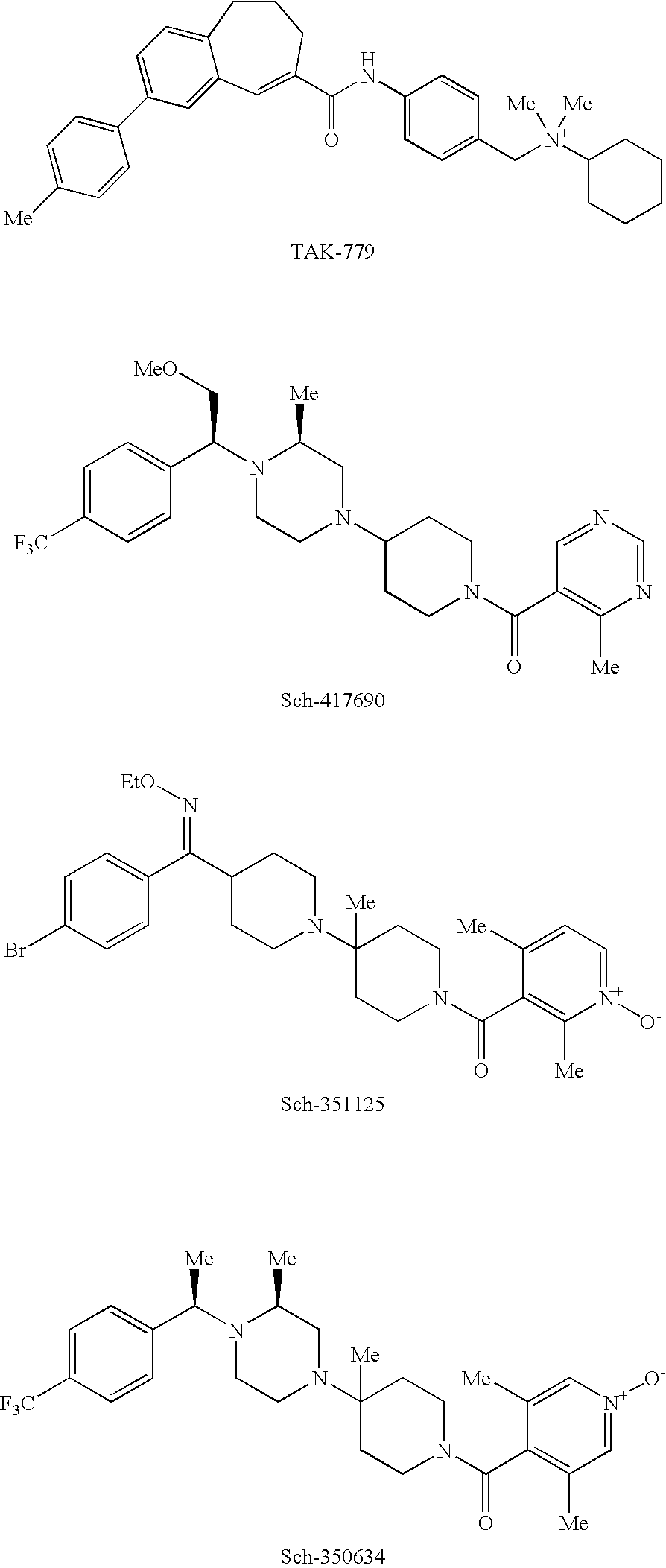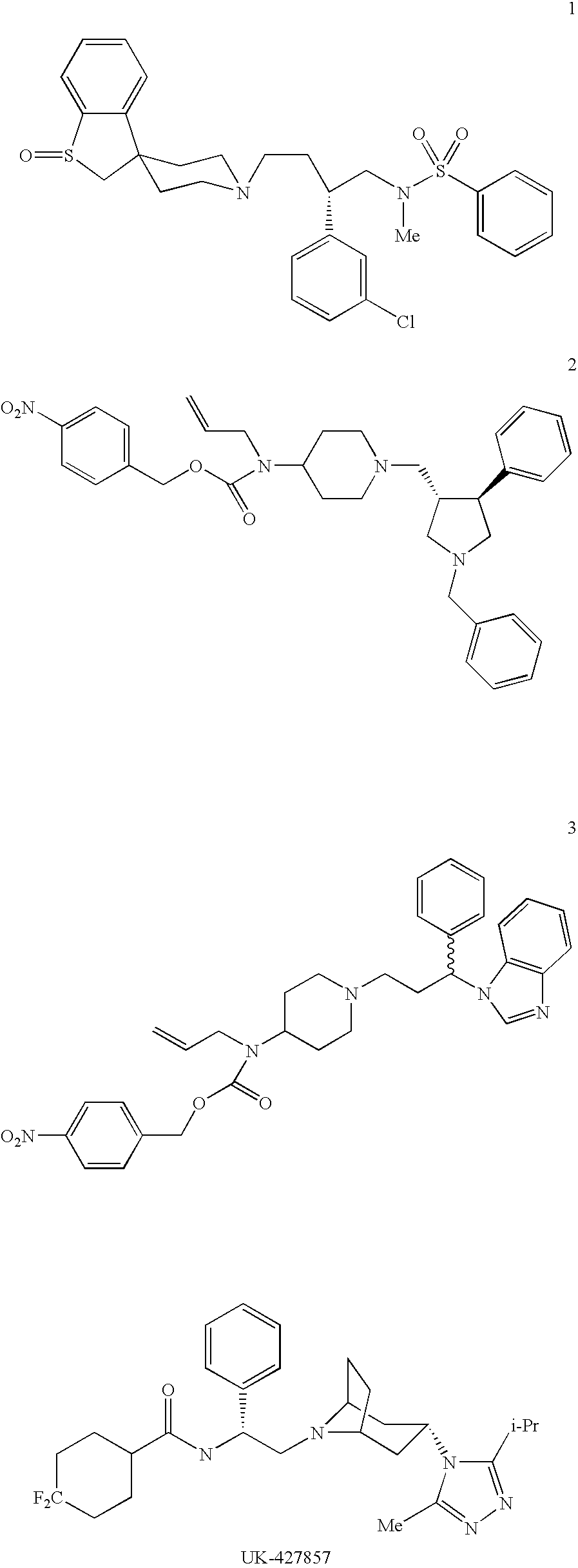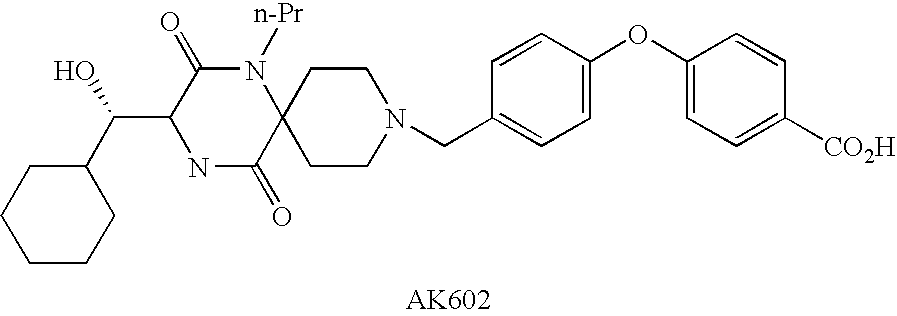Heterocyclic antiviral compounds
a heterocyclic compound and antiviral technology, applied in the field of piperidine derivatives, can solve the problems of high complex dosing regime, side effects which can be very severe, and limit the utility of long-term therapy
- Summary
- Abstract
- Description
- Claims
- Application Information
AI Technical Summary
Benefits of technology
Problems solved by technology
Method used
Image
Examples
example 1
4-Butyl-3-cyclohexylmethyl-8-[1-(2,6-dimethyl-benzoyl)-piperidin-4-yl]-1-oxa-3,8-diaza-spiro[4.5]decan-2-one (I-1)
[0203]
Step 1: 4-(1-Carboxy-pentyl)-4-hydroxy-piperidine-1-carboxylic acid benzyl ester
[0204]
[0205]To a solution of 15 mL (124 mmol) diisopropyl amine in 90 mL anhydrous THF at −40° C. was added dropwise 45 mL (113 mmol) of n-butyl lithium (2.5 M in hexanes) The reaction mixture was warmed to 0° C. A solution of 6.7 mL (62.1 mmol) hexanoic acid in 60 mL anhydrous THF was added dropwise. The reaction mixture stirred at −20° C. for an additional 20 m. The reaction mixture was cooled to −78° C. A solution of 15 g (64.3 mmol) benzyl 4-oxo-1-piperidine-carboxylate in 60 mL anhydrous THF was added dropwise. The reaction mixture slowly warmed to room temperature over 18 h. The reaction was quenched by addition of 25 mL of water. The mixture was acidified to pH 2 with 6N HCl. The aqueous layer was thrice extracted with EtOAc. The combined organic phase was dried over magnesium su...
example 2
4-(4-Butyl-3-cyclohexylmethyl-2-oxo-1-oxa-3,8-diaza-spiro[4.5]dec-8-yl)-4-methyl-piperidine-1-carboxylic acid (2,6-dimethyl-phenyl)-amide (I-80)
[0215]
Step 1: 4-(4-Butyl)-3-cyclohexylmethyl-2-oxo-1-oxa-3,8-diaza-spiro[4,5]dec-8-yl)-4-cyano-piperidine-1-carboxylic acid tert-butyl ester (18: R=Boc; R′=n-Bu; R″=c-C5H11)
[0216]
[0217]To a solution of 14 (R′=n-Bu; R″=c-C5H11; 2.46 mmol) in 60 mL of dichloromethane was added N-Boc-4-piperidone, (10: R=Boc; 515 mg: 2.58 mmol) at RT. The stirred reaction was maintained under a nitrogen atmosphere for 30 m. Ti(IV)(O-i-Pr)4 (1 mL; 3.44 mmol) was added to the reaction and the mixture was stirred at RT for 12 h and then refluxed for 4 h. The reaction mixture was cooled to room temperature and diethylaluminum-cyanide (3.8 mL; 3.87 mmol) was added and stirring was continued for another 5 days. The reaction mixture was diluted with 50 mL of dichloromethane and a few drops of 1N NaOH were added until aluminum granulates could be removed by filtration ...
example 3
8-(1-Benzenesulfonyl-piperidin-4-yl)-4-butyl-3-cyclohexylmethyl-1-oxa-3,8-diaza-spiro[4.5]decan-2-one (I-71)
[0223]
[0224]To a solution of 19b (R=n-Bu; R″=c-C5H11; 1.0 g; 2.24 mmol), TEA (0.311 mL; 0.226 g; 2.24 mmol) and 25 mL of Et2O was added 1.79 g of toluenesulfonyl chloride (9.78 mmol). The reaction mixture was stirred at RT for 18 h. The solid triethylammonium chloride was filtered and the volatile solvents were evaporated in vacuo. The residue was partitioned between EtOAc and 1N NaOH. The organic layer was washed with water and brine, dried over magnesium sulfate, and evaporated to afford I-71. The crude product was purified by flash chromatography on silica gel.
PUM
 Login to View More
Login to View More Abstract
Description
Claims
Application Information
 Login to View More
Login to View More - R&D
- Intellectual Property
- Life Sciences
- Materials
- Tech Scout
- Unparalleled Data Quality
- Higher Quality Content
- 60% Fewer Hallucinations
Browse by: Latest US Patents, China's latest patents, Technical Efficacy Thesaurus, Application Domain, Technology Topic, Popular Technical Reports.
© 2025 PatSnap. All rights reserved.Legal|Privacy policy|Modern Slavery Act Transparency Statement|Sitemap|About US| Contact US: help@patsnap.com



